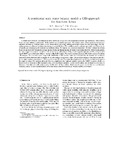| dc.description.abstract | A distributed GIS-based hydrological model is developed using GIS and computational hydrology techniques. The model is
based on water balance consideration of the surface and subsurface processes. The surface water balance processes include precipitation
infiltration, overland runoff, evapo-transpiration and canopy surface interception losses on daily time steps; The subsurface
process considers soil moisture accounting on a monthly basis. The model was used to estimate generated runoff from matrix
of specific geo-referenced grids representing Southern Africa. All regional and seasonal dispensation of water balances have been
based on standard GIS formats for storage, spatial display and interpretation of results. Considering the 1961–1990 climatic period,
we have mapped the regional variation of the mean annual soil moisture (SM), actual evapo-transpiration (AET), and generated
runoff (ROF) across Southern Africa or known as the SADC region. The model estimates the mean SM of the region to be about
148 mm/year. There is a wide spatial range in the distribution of SM over the region due to the fact that the absolute soil moisture is
dependent on the water retention properties of the soils considered across the region. The model prediction of the mean annual AET
in the region reaches a maximum of 1500 mm, with mean 420 mm. The mean annual generated runoff from the land catchment in
the region is about 151 mm/year although there is a significant inter-regional variation among the SADC countries, which is a
function of the variation in the vegetation cover, soil and climate variation. Lower runoff regimes are dominant in arid areas in
Botswana, Namibia and south-western part of the Republic of South Africa. Higher runoff regimes are the Northern and Western
Tanzania, along the east coastal portions of Mozambique, central Mozambique, western Zambia and Malawi. | en_US |

